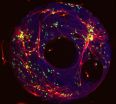(Press-News.org) A new article published by Cell Press in the May 26 issue of the journal Neuron provides comprehensive insight into the current status of neural stem cell research and the sometimes labyrinthine pathways leading to stem cell-based therapies. The perspective on translating neural stem cell research into clinical therapeutics is part of a special issue of Neuron devoted to neural stem cells and neurogenesis and is published in collaboration with the May issue of Cell Stem Cell, which also has a selection of reviews on this topic.
Neurological disease and injury are a major cause of disability worldwide, and there is a pressing need to find reparative therapeutics for the central nervous system (CNS). Although stem cell therapies represent the frontier of regenerative medicine, the "bench to bedside" leap where scientific discoveries in the laboratory are translated to actual patient therapeutics faces many challenging hurdles.
"Stem cell research is one of the most rapidly developing areas of science and medicine," says study author Dr. Sally Temple from the Neural Stem Cell Institute in Rensselaer, New York. "The explosive rise in discoveries and technologies that we see in the basic research labs has yet to enter the pipeline, and there is an enormous gap between what we can do at the bench and what we see in the current clinical trials. It is imperative that we work towards making the process of translation more effective and affordable."
In their article, Dr. Temple and colleagues describe the current status of stem cell-based CNS therapies, analyze currently approved clinical trials, and discuss key issues associated with translational progress. The authors report that many basic scientists are struggling with low funding levels and that funding cutbacks substantially impede new research directions. They suggest that successfully transitioning from the lab to the clinics requires a comprehensive and collaborative team effort among researchers, clinicians, regulatory agencies, patient advocacy groups, ethics bodies, and industry, and they stress that pioneering this new partnership model is essential for smooth translational path that will improve the chance that the health benefits of research reach patients.
"There is no doubt that stem cell research and application is opening great opportunities in CNS regenerative therapies and, although our survey shows that we are still at relatively early stages of defining safety for human trials, stupendous strides are being made in preclinical studies," says Dr. Temple. "However, we must engage basic researchers and their institutions to ensure that they participate in the rewards of successful translation and benefit from revenue return that will fund further creative discoveries. We envision a much more concerted effort towards translation that would make the process more accessible and efficient, forging new private/public partnerships that will spread both risks and benefits in the process. Ultimately, the rewards of solving this problem could be seen at every level, from the next generation of young scientists to the patients. We need to take steps soon, as the challenge posed by neurological disorders is growing."
### END
Can we get there from here? Translating stem cell research into therapies
2011-05-26
ELSE PRESS RELEASES FROM THIS DATE:
Endangered gourmet sea snail could be doomed by increasing ocean acidity
2011-05-26
Increasing levels of ocean acidity could spell doom for British Columbia's already beleaguered northern abalone, according to the first study to provide direct experimental evidence that changing sea water chemistry is negatively affecting an endangered species.
The northern abalone--prized as a gourmet delicacy--has a range that extents along the North American west coast from Baja California to Alaska. Even though British Columbia's northern abalone commercial fisheries where closed in 1990 to protect dwindling populations, the species has continued to struggle, largely ...
Japan earthquake appears to increase quake risk elsewhere in the country
2011-05-26
Japan's recent magnitude 9.0 earthquake, which triggered a devastating tsunami, relieved stress along part of the quake fault but also has contributed to the build up of stress in other areas, putting some of the country at risk for up to years of sizeable aftershocks and perhaps new main shocks, scientists say.
After studying data from Japan's extensive seismic network, researchers from the Woods Hole Oceanographic Institution (WHOI), Kyoto University and the U.S. Geological Survey (USGS) have identified several areas at risk from the quake, Japan's largest ever, which ...
Syracuse University scientists discover new hitch to link nerve cell motors to their cargo
2011-05-26
With every bodily movement—from the blink of an eye to running a marathon—nerve cells transmit signals to muscle cells. To do that, nerve cells rely on tiny molecular motors to transport chemical messengers (neurotransmitters) that excite muscles cells into action. It's a complex process, which scientists are still trying to understand. A new study by Syracuse University researchers has uncovered an important piece of the puzzle.
The study, published in the April 22 issue of the Journal of Biological Chemistry (JBC), describes the discovery of a protein that is involved ...
Rethinking extinction
2011-05-26
For more than 40 years, the International Union for Conservation of Nature (IUCN) has published the Red List of Threatened Species describing the conservation status of various species of animals. They are now also including plants in their lists and the picture they present is dramatic. According to recent estimates, around 20 per cent of flowering plants are currently at risk of extinction – though the exact number is unknown since such a small proportion of plant species has even been measured.
Now, however, research conducted in South Africa and the U.K. by an international ...
Study shows elderly drivers support competency tests
2011-05-26
AURORA, Colo. (May 25, 2011) – Researchers studying driving habits and accident rates among the elderly found a majority surveyed supported mandatory retesting of drivers based on age while saying they would hand over the keys if a doctor or loved one said they were no longer fit to drive.
"We are now exploring the idea of an advance directive for driving where someone would be designated to take away your keys at some point," said Emmy Betz, MD, MPH, at the University of Colorado School of Medicine who led the study and presented it in May before the American Society ...
Study details path to sustainable aviation biofuels industry in Northwest
2011-05-26
SEATTLE–The Pacific Northwest has the diverse feedstocks, fuel-delivery infrastructure and political will needed to create a viable biofuels industry capable of reducing greenhouse gases and meeting the future fuel demands of the aviation industry. Creating an aviation biofuels industry, however, will depend upon securing early government policy support to prioritize the aviation industry in U.S. biofuel development.
That's the conclusion announced today in a 10-month study by Sustainable Aviation Fuels Northwest (SAFN), the nation's first regional stakeholder effort to ...
Most labor unions unlikely to follow decertification path of NFL players
2011-05-26
CHAMPAIGN, Ill. — With legislation to diminish private- and public-sector collective bargaining rights already in the books in Wisconsin and Ohio, should more labor unions steal a page from the playbook of the NFL Players Association and decertify? Although there are parallels between the pros and regular Joes (and Janes), union decertification is not a viable strategy for ordinary workers to use when bargaining for better wages and working conditions, says a University of Illinois law and labor expert.
Whether it's a teacher in Wisconsin or a construction worker in Indiana, ...
Autism changes molecular structure of the brain, UCLA study finds
2011-05-26
For decades, autism researchers have faced a baffling riddle: how to unravel a disorder that leaves no known physical trace as it develops in the brain.
Now a UCLA study is the first to reveal how the disorder makes its mark at the molecular level, resulting in an autistic brain that differs dramatically in structure from a healthy one. Published May 25 in the advance online edition of Nature, the findings provide new insight into how genes and proteins go awry in autism to alter the mind.
The discovery also identifies a new line of attack for researchers, who ...
Caltech-led team debunks theory on end of 'Snowball Earth' ice age
2011-05-26
PASADENA, Calif.—There's a theory about how the Marinoan ice age—also known as the "Snowball Earth" ice age because of its extreme low temperatures—came to an abrupt end some 600 million years ago. It has to do with large amounts of methane, a strong greenhouse gas, bubbling up through ocean sediments and from beneath the permafrost and heating the atmosphere.
The main physical evidence behind this theory has been samples of cap dolostone from south China, which were known to have a lot less of the carbon-13 isotope than is normally found in these types of carbonate rocks. ...
Pitt team recreates brain cell networks with new view of activity behind memory formation
2011-05-26
PITTSBURGH—University of Pittsburgh researchers have reproduced the brain's complex electrical impulses onto models made of living brain cells that provide an unprecedented view of the neuron activity behind memory formation.
The team fashioned ring-shaped networks of brain cells that were not only capable of transmitting an electrical impulse, but also remained in a state of persistent activity associated with memory formation, said lead researcher Henry Zeringue [zuh-rang], a bioengineering professor in Pitt's Swanson School of Engineering. Magnetic resonance images ...



